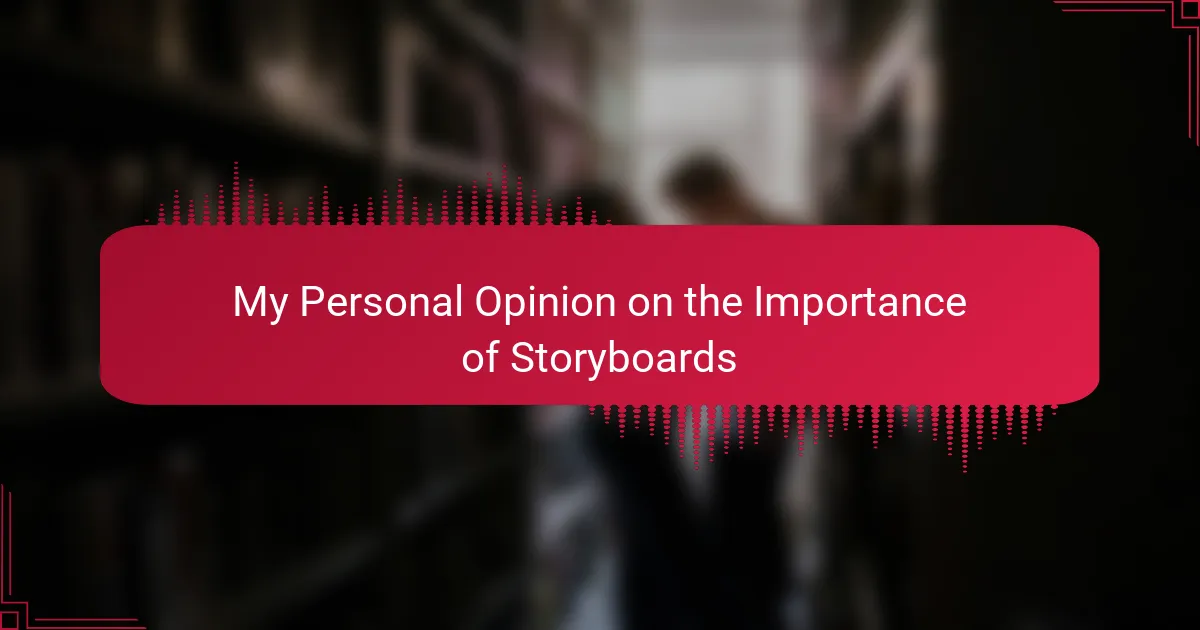Key takeaways
- Storyboards serve as essential visual blueprints in comics, clarifying narrative flow and emotional depth.
- Effective storyboards enhance pacing, character development, and communication among collaborators, saving time during production.
- Key elements for effective storyboarding include clarity, emotional expression, panel flow, and the use of directional cues.
- Improving storyboard skills requires consistent practice, exploration of different styles, and feedback from peers.
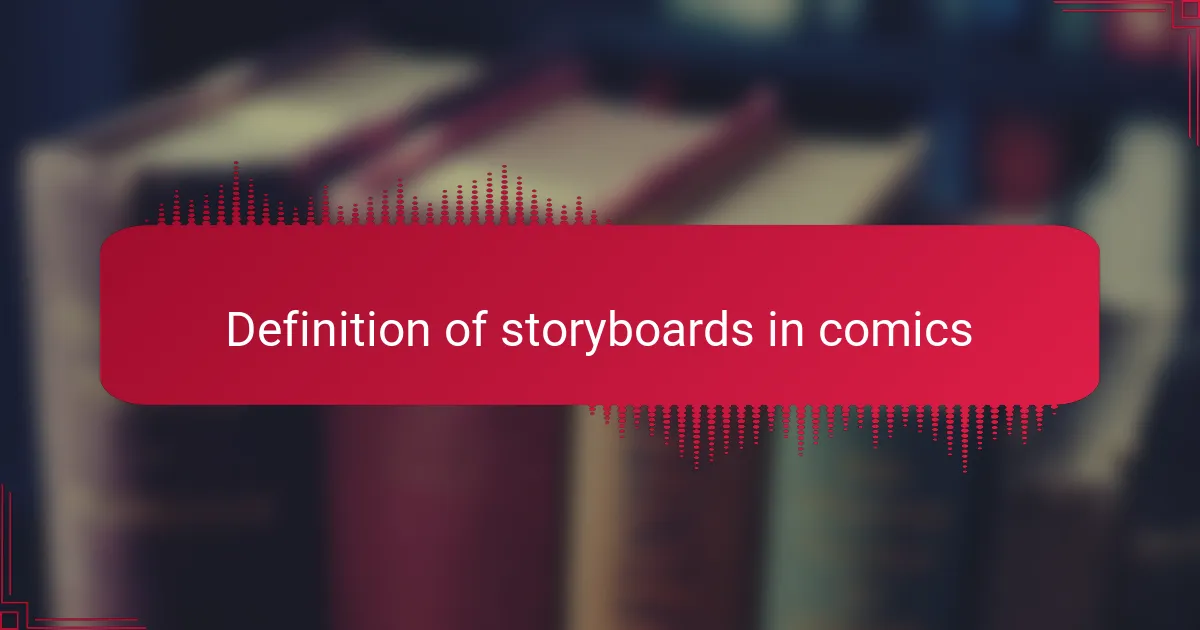
Definition of storyboards in comics
Storyboards in comics serve as visual blueprints for the narrative, breaking down the storyline into a sequence of panels. Each panel outlines key scenes, character actions, and dialogue, guiding the flow from one moment to the next. I often think of a storyboard as the heart of a comic; it lays the groundwork for the entire creative process.
When I first started creating comics, I remember feeling overwhelmed by the blank page. It wasn’t until I began sketching out storyboards that everything clicked into place. By visualizing the story ahead of time, I could experiment with pacing and composition, ensuring the final product resonated with readers.
The beauty of storyboards lies in their flexibility. They encourage exploration and invite revision, allowing creators to refine their ideas before committing to detailed artwork. Have you ever noticed how animated the characters appear in some comic panels? That energy often stems from thoughtful storyboarding, which captures not just the actions, but the emotions behind them.

Benefits of using storyboards
When I first started creating comic books, I underestimated the power of storyboards. I quickly learned that laying out my ideas visually helped me see the flow of the narrative and the pacing of the action. It was almost like a map guiding me through the creative journey, ensuring I didn’t lose my way amidst the myriad of details.
The benefits of using storyboards in comic creation are truly invaluable:
- Visual Clarity: They provide a clear vision of how each panel connects, making complex narratives easier to manage.
- Pacing Control: By seeing the layout, I can adjust pacing and ensure my story’s tempo resonates with readers.
- Character Development: Storyboards help me visualize character interactions, enhancing their emotional depth.
- Time Efficiency: Planning ahead saves time during the actual drawing phase, allowing for a smoother workflow.
- Communication Tool: They serve as an excellent communication tool when collaborating with artists and editors, ensuring everyone is on the same page.
Having that initial storyboard made all the difference in not just my organization but in how much I enjoyed the creative process overall.
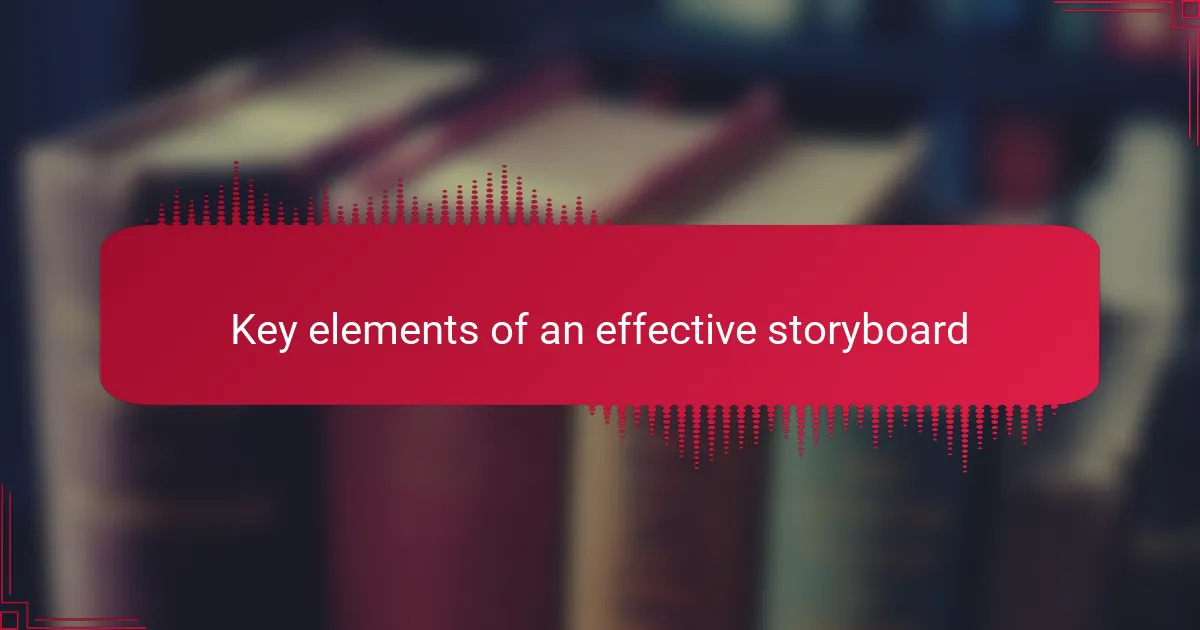
Key elements of an effective storyboard
When I think about the key elements of an effective storyboard, clarity jumps out as the most essential factor. Every panel needs to succinctly convey the story’s action and emotion. I remember the first time I created a storyboard for my comic; I realized that visuals alone don’t communicate everything. The placement of characters, their expressions, and the background all play a significant role in guiding the reader’s experience.
Another vital component is the flow of the story. You want each panel to naturally lead to the next, maintaining a rhythm that keeps readers engaged. In my case, I discovered that using directional arrows within the storyboard helped me map out the visual journey more effectively. It’s like creating a visual roadmap, where every twist and turn enhances the storytelling experience.
Key elements of an effective storyboard:
– Clarity: Each panel should be clear and straightforward.
– Emotional expression: Characters’ emotions need to be visually evident.
– Panel flow: Ensure smooth transitions between panels.
– Visual pacing: Maintain a rhythm that fits the story’s tone.
– Directional cues: Use arrows or notes for guidance on movement and transitions.

How to create a storyboard
Creating a storyboard is an exciting part of the comic creation process. It allows me to visualize the flow of the story, ensuring that each panel effectively conveys the action and emotion. I remember the first time I used a storyboard—seeing my ideas come to life on paper gave me a rush of motivation that drove the rest of my creative process.
To craft an effective storyboard, consider these steps:
- Determine the key scenes: Identify the most important moments of your story.
- Sketch rough panels: Don’t worry about perfection; just get your ideas down visually.
- Add dialogue and notes: Include speech bubbles and any important direction for characters or action.
- Establish pace: Think about how long each scene will last and how quickly the story unfolds.
- Revise and refine: Go back through your storyboard, making adjustments as necessary to enhance clarity and impact.
By following this process, I’ve found that storyboarding not only organizes my thoughts but also makes the storytelling more dynamic.
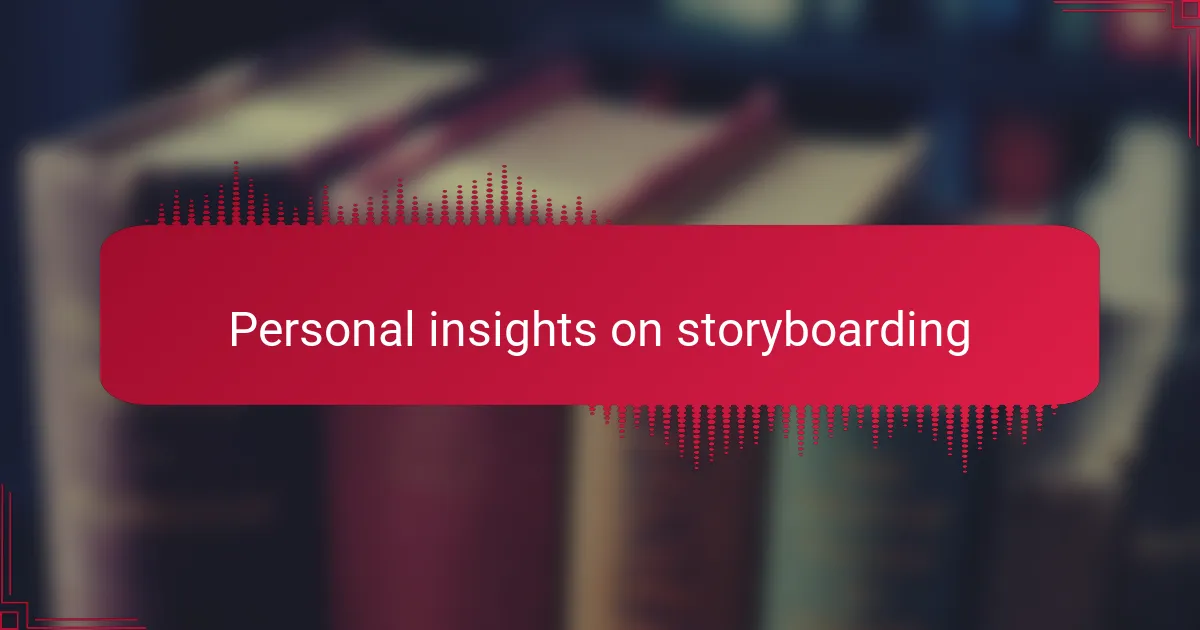
Personal insights on storyboarding
When it comes to storytelling, storyboards are like maps for a journey. In my experience as a comic book author, using storyboards helps me visualize the flow of the narrative. I remember the first time I sketched out a storyboard for a project; it felt like breathing life into my ideas.
What really stood out was how storyboarding allowed me to experiment with pacing and panel transitions. It’s like having a rehearsal for my comics. I found that when I laid it all out, I could spot inconsistencies and areas that needed enhancement before diving into the final artwork.
Moreover, the emotional journey of bringing characters to life starts with these sketches. Storyboards don’t just show action; they capture the essence of what each panel needs to convey. They help bridge the gap between thoughts and visuals, which is crucial for creating a compelling narrative.
| Aspect | Without Storyboard |
|---|---|
| Clarity | Often unclear, leading to confusion |
| Pacing | Inconsistent flow and transitions |
| Character Development | Surface-level exploration |
| Visual Consistency | Increased risk of visual errors |
| Creative Freedom | Less room for experimentation |
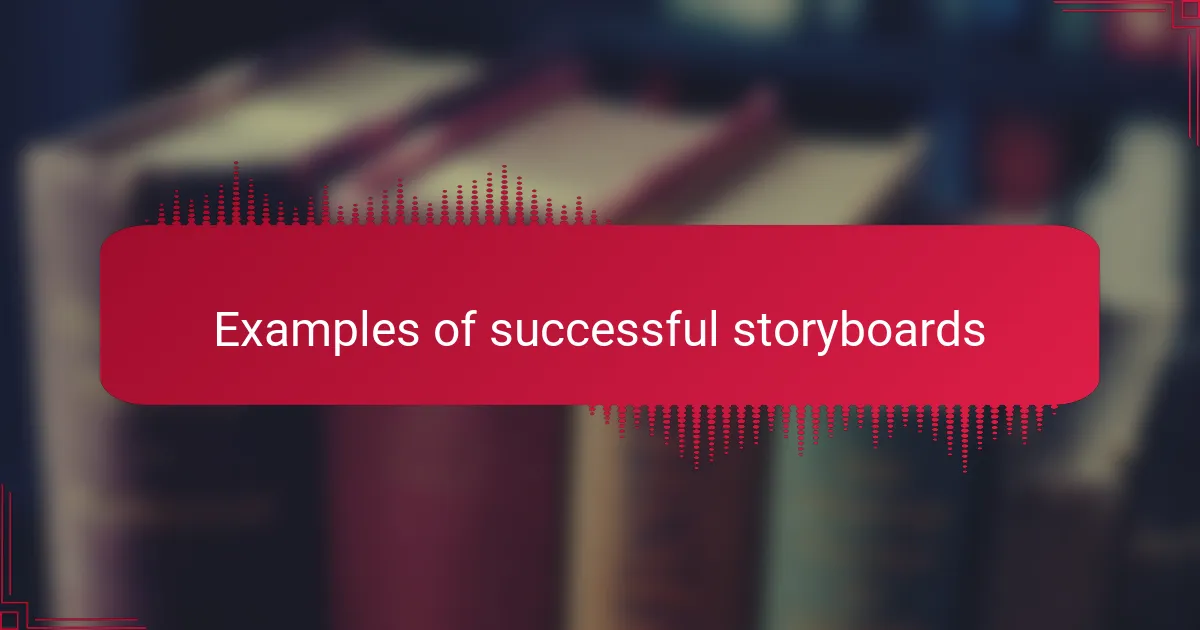
Examples of successful storyboards
Creating effective storyboards isn’t just about drawing; it’s about translating the essence of your story into a visual format. One example that stands out for me is the storyboard work done for Scott Pilgrim vs. The World. The director, Edgar Wright, utilized storyboards extensively to plan dynamic action sequences and character interactions meticulously. By mapping out these visuals ahead of time, the flow and energy of each scene were not only captured but enhanced, making the final film a visual treat. It’s refreshing to witness how well-structured storyboards can lead to captivating storytelling.
Another notable instance is seen in the animated series Avatar: The Last Airbender. The creators employed detailed storyboards that emphasized not just the overarching narrative but also subtle character moments. I remember watching those episodes and realizing how much the pacing was influenced by the way the storyboards laid out the emotional beats. The creators made sure every frame had a purpose, and that level of forethought is what brought the characters to life, creating a genuine connection with the audience.
A more personal example arises from my own journey in comic creation. When I plotted out my storyboard for a pivotal scene—one where my protagonist faced a moral dilemma—I sketched out different emotional expressions and reactions. This storyboard allowed me to explore variations in pacing as I thought through the dialogue. Reflecting on that process, I feel it was crucial in shaping how readers would ultimately perceive the character’s growth. Isn’t it fascinating how a simple bunch of panels can have such a profound impact on storytelling?
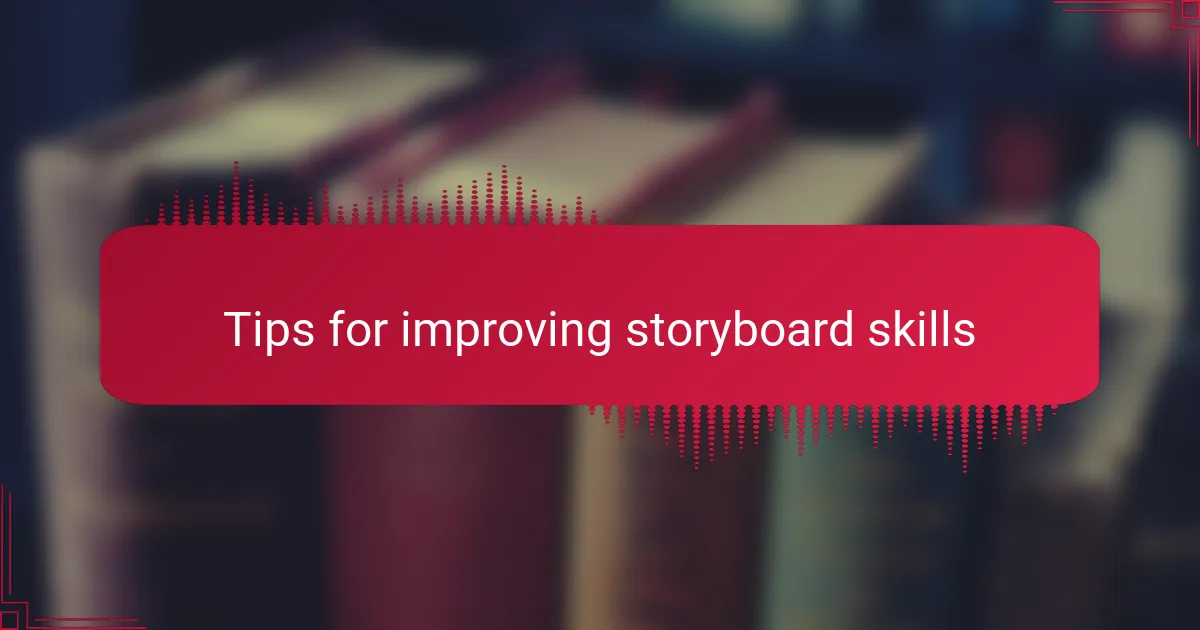
Tips for improving storyboard skills
When it comes to improving storyboard skills, practice is key. I remember my early days sketching out ideas on napkins and scraps of paper. Each attempt pushed me to rethink layouts and pacing, reinforcing the notion that continuous practice not only hones your skills but also builds confidence.
Another essential tip is to explore different styles and techniques. I’ve experimented with various mediums, from digital tools to traditional pencil and paper. This exploration has enriched my storytelling approach, allowing me to think outside the box and embrace diverse visual narratives.
Lastly, seeking feedback can be incredibly beneficial. I once shared early drafts with fellow creators and discovered fresh perspectives that transformed my story arcs. Constructive criticism can challenge your thinking and help sharpen your storyboarding abilities in ways you’d never expect.
| Tip | Description |
|---|---|
| Practice Regularly | Consistent practice develops your skills and boosts confidence. |
| Explore Different Styles | Diversifying your approach can enhance your storytelling and visual techniques. |
| Seek Feedback | Input from peers can offer new perspectives and challenge your creativity. |
